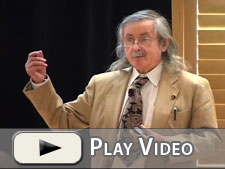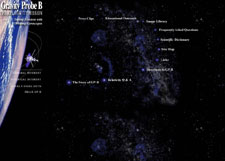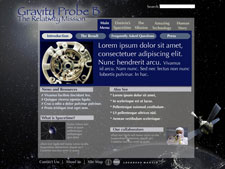GP-B Mission News — Spring 2008
On this page:
May 2008: Francis Everitt Gives GP-B Talk at Stanford Aero-Astro 50th Anniversary Symposium
Because GP-B is a basic physics experiment that has to be performed in outer space, one of the most essential ingredients to its success over the past 45+ years has been the close collaboration between the Physics and Aeronautics & Astronautics departments at Stanford. For example, one of the critical requirements of the GP-B experiment is that the spacecraft had to fly drag-free in its orbit throughout the experimental (data collection) phase of the mission.
Beginning in the mid 1960s, under the leadership of GP-B co-founder, Robert Cannon, the Stanford Aero-Astro department pioneered the development of drag-free satellite technology, and in the early 1970s, GP-B Co-Principal Investigator, Dan DeBra (now a Professor Emeritus in Stanford’s Aero-Astro Department), led the development, in collaboration with Johns Hopkins Applied Physics Laboratory, of the first drag-free satellite ever flown—the Disturbance Compensation System (DISCOS) drag-free controller for the U. S. Navy’s TRIAD transit navigation satellite, successfully launched in July 1973. Research and development in drag-free satellites and related technologies carried out in the Stanford Aero-Astro Department for GP-B over several decades ultimately led to a number of spin-offs and other applications of these technologies. Also, 65% of the 85 Stanford Ph.D. dissertations concerning various aspects of GP-B over the past 45+ years were written by graduate students in the Stanford Aero-Astro Department under the guidance of Professor DeBra, Professor Bradford Parkinson and the late Professor John Breakwell.

Francis Everitt talks about Aero-Astro
engineering contributions to GP-B
at the 50th anniversary celebration
In May 2008, the Stanford Aero-Astro Department celebrated its 50th anniversary. In honor of this occasion, the department put on a three-day symposium that included over a dozen speakers—including many former Aero-Astro graduates—whose talks looked back over the history and accomplishments of the department, as well as looking forwards towards future goals and frontiers in aeronautics and astronautics.
GP-B Principal Investigator, Francis Everitt, gave one of these talks entitled: Gravity Probe B, the Engineering of a Physics Experiment in Space and the Role of Students in it. In this talk, Everitt traces the history and development of the GP-B experiment and technologies, acknowledging at each step along the way, students and faculty from the Aero-Astro Department who played critical roles in the program. Professor Everitt's 40-minute talk was videotaped, and you can click on the Play Button to the right to view a Flash Video version of this talk. You can also download a PDF copy of the PowerPoint slides that Professor Everitt used during his talk.
March 2008: GP-B Web Site Gets A Complete Makeover
Editor's Note: Welcome to our new Web site! On the occasion of opening our new site to the world, it seems appropriate to look back briefly on the history of our Web site, give credit and thanks to the people who laid the foundations on which we have built this new site, and also describe our goals in giving our site its second, and final makeover. —Bob Kahn, GP-B Public Affairs Coordinator
A Brief History of the GP-B Web Site
The GP-B Web site is now 11 years old. The original site was created by Jennifer Spencer, who joined the GP-B team in 1995. Spencer's primary responsibility at GP-B was management and maintenance of our science data base and other data processing duties. However, she also took on the responsibility of creating the first GP-B Web site, and she served as GP-B Webmaster until June 2007, when she transferred from GP-B to the Stanford Solar Physics Research Group. To the right is a screen capture from the Home page of that early version of the site.
Then, as now, the purpose of our Web site was to provide both laymen and scientists information about the progam, the science behind it, and its ongoing status. Over the years, Spencer maintained and updated the site, adding information about interesting GP-B technologies, the developing spacecraft, gravity and relativity, and much more. She also created and maintained both a physical and electronic photo and image archive which has become an essential resource for members of the GP-B team, as well as the press and media. A selected subset of this image archive comprises the picture gallery on the Web site.
One of the most important "spinoffs" of GP-B over its 45+ year lifetime has been student involvement, and this certainly has been the case with regards to the GP-B Web site. When Spencer began to develop the first version of the GP-B Web site in the late 1990s, she enlisted the aid of a local high school student to do some of the HTML coding and help with graphic design. Around 2001, a Stanford undergraduate student named Katherine Stephenson was hired to work on the GP-B program as a part-time graphic designer. Signs of Stephenson's talent and her prolific work are visible everywhere at GP-B. For example, she worked with GP-B's Educational and Public Outreach Coordinator, Shannon Range, to design the GP-B triptych (3-panel) spacetime poster, the cover artwork on the GP-B Teacher's Guide, and the GP-B educational lithograph cards. Working with Spencer, Stephenson also created several other GP-B posters, as well as graphic images and collages that were used on the GP-B Web site. Two of Stephenson's most ambitious projects, that have been featured on the previous and current version of our Web site are:
The 2003 Web site Makeover
In 2003, Stephenson collaborated with Spencer to give the GP-B Web site its first makeover. Together, they re-designed and implemented a new graphic look and frame-based navigation structure that replaced the original design in the Fall of 2003. I joined the GP-B team as Public Affairs Coordinator in 2003, and around the time that the new Web site design went live, I was asked to assume responsibility for maintaining the content of the Web site Home/Status page—that is, writing the weekly mission highlights/news stories (later monthly and now quarterly status updates) and preparing the accompanying graphics. To the right is a screen capture of that design, showing our December 2007 GP-B Status Update. Anyone who has been a frequent visitor to our Web site over the past few years will immediately recognize this distinctive style.
The GP-B Legacy Web Site Makeover
In the Fall of 2006, I met with GP-B Education & Public Outreach Coordinator, Shannon Range, to discuss what kind of public legacy GP-B should leave behind after the announcement of final results and the subsequent conclusion of the program. The answer was clear to both of us: the GP-B Web site would be the one place that anyone could visit to find out anything about the program—history, technology, scientific underpinnings, results, images, etc. As excellent as the existing site was, both Range and I felt strongly that in order to serve as a "one stop shopping" legacy of GP-B, our site needed another makeover—both structural and visual. Structurally, the site navigation needed to be more intuitive and easy to use, and also the site's massive content needed to be reorganized; certain program documents and information needed to be more prominent, the site needed to better facilitate browsing, and GP-B's rich collection of audio and video needed to be integrated into the site content. Visually, we wanted to maintain an "outer space" theme, but we also felt that it was important to display pages in a more sculpted and readable format; e.g., black or dark-colored text on a white or light-colored background, rather than white text on a starry background. In terms of site navigation, we both felt that some kind of tab metaphor would be much preferable to the existing dynamic menu system.
In January 2007, Range and I met with Spencer to discuss our proposed makeover. With skeptical blessing from our management team, the three of us began collaborating part-time on this project, since we all had other responsibilities. Our intention was not to create new content for the site, but rather to re-organize our existing content and to develop a more intuitive and easier-to-navigate visual interface for displaying the information. Furthermore, in early 2007, GP-B was preparing to announce our first experimental results at the APS meeting in April 2007, and it was our intention for the re-designed site to "go live" at that time.
In the months leading up to the April 2007 APS meeting, Range took the lead in developing the architecture and navigation for the new site, and Spencer worked on graphic design and site mock-ups. The image to the right is one of the mock-ups we created for a new Home page. I was too busy getting ready for the announcement of first results to be of much help to the team at that time. Not surprisingly, the challenge of having our new site up and running in time for the APS meeting proved to be unrealistic, as borne out by the fact that we are now finally going live with the redesigned site a year later. However, we were able to progress far enough to convince GP-B management that the project was worth completing.
In June 2007, as part of a planned GP-B staff reduction, both Spencer and Range left the program. Spencer transferred to the Solar Physics Research Program, and Range completed his doctoral dissertation in the Stanford School of Education, got his Ph.D. and started searching for a full-time job. Thus, the daunting task of completing our new Web site was left completely in my hands. However, I obtained critically important technical assistance in developing the site from Brian Young, a member of the Stanford Information Technology Department's Web Site Development Team. Early on in our new site development efforts, it became apparent that we would need help addressing a number of technical issues, such as cross-browser icompatibilities and the design and implementation of advanced stylistic elements. We thus established a consulting relationship with Young to get advice on how to solve some of these issues. By August 2007, it became clear that I would need considerable assistance from Young, and we thus arranged for him to work closely with me for several months. The elegant look of our new site pages represents Young's masterful implementation of various stylistic elements, from rounded-cornered tabs to translucent page frames.
I have been working on the content of the site for nine months now, including the captioned animations, flash video clips, and the content of the Mission and Technology tabs. For the contents of the Spacetime tab, I am indebted to James Overduin, a visiting physicist who is a member of our GP-B theoretical physics group. Over a period of three months, Overduin composed the entire contents of the Spacetime tab, a task comparable to writing five complete entries in the Wikipedia.
On behalf of everyone who has worked on our new site, I hope you find it easy to navigate, interesting to browse and enlightening. We welcome your feedback. If you have comments or suggestions, please feel free to contact the GP-B Webmaster (that's me now) at: www@relgyro.stanford.edu



